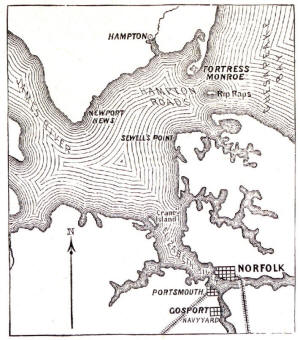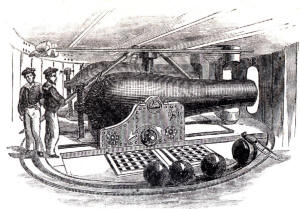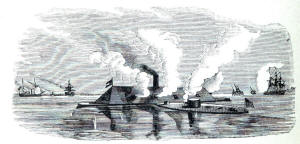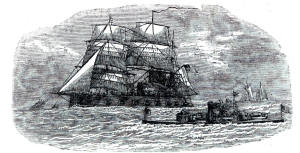|
This Site:
Civil War
Civil War Overview
Civil War 1861
Civil War 1862
Civil War 1863
Civil War 1864
Civil War 1865
Civil War Battles
Confederate Generals
Union Generals
Confederate History
Robert E. Lee
Civil War Medicine
Lincoln Assassination
Slavery
Site Search
Civil War Links
Civil War Art
Revolutionary War
Mexican War
Republic of Texas
Indians
Winslow Homer
Thomas Nast
Mathew Brady
Western Art
Civil War Gifts
Robert E. Lee Portrait
|
Monitor and Merrimac. At the moment when the Confederates evacuated Manassas a strange naval battle occurred in Hampton Roads. The Confederates had raised the sunken Merrimac in the Gosport
navy yard and converted it into an iron-clad ram, which they called the Virginia, commanded by Captain Buchanan, late of the United States navy. She had gone down to Hampton Roads and destroyed (March 8, 1862) the wooden sailing frigates Congress and Cumberland, at the mouth of the
James River, and it was expected she would annihilate other ships there the next morning. Anxiously the army and navy officers of that vicinity passed the night of the 8th, for there appeared no competent human agency near to avert the threatened disaster. | 
MAP OF HAMPTON ROADS | Meanwhile another vessel of novel form and aspect had been constructed at Greenpoint. L. I., N. Y., under the direction of
CAPT. JOHN ERICSSON, who used Theodore R. Timby's invention of a revolving turret. It presented to the eye, when afloat, a simple platform, sharp at both ends, and bearing in its centre a round Martello tower 20 feet in diameter and 10 feet in height, made, as was the rest of the vessel, of heavy iron. It presented a bomb-proof fort, in which were mounted two 11-inch
Dahlgren guns. The hull of this vessel was only 8 1/2 feet in depth, with a flat bottom, and was 124 feet in length, and 34 feet the greatest width at top. On this hull rested another, 5 feet in height, that extended over the lower one 3 feet 7 inches all around, excepting at the ends, where it projected 25 feet, by which protection was afforded the anchor, propeller and rudder. The whole was built of 3 inch iron, and was very buoyant. Its exposed parts were guarded by a wall of white oak, 30 inches in thickness, on which was laid iron armor 6 inches in thickness. | A shot to strike the lower hull would have to pass through 25 feet of water, and then strike an inclined plane of iron at an angle of about 10°. The deck was well armed also. Such was the strange craft that entered Hampton Roads from the sea, under the command of
LIEUT. JOHN L. WORDEN, unheralded and unknown, at a little past midnight, March 9, on its trial trip. It had been named
Monitor. It had been towed to the Roads by steamers, outriding a tremendous gale. | 
INTERIOR OF THE MONITOR'S TURRET |
Worden reported to the flag officer of the fleet in the Roads, and was ordered to aid the
Minnesota in the expected encounter with the Merrimac in the morning. It was a bright Sabbath morning. Before sunrise the dreaded Merrimac and her company came down from
Norfolk. The stern guns of the Minnesota opened upon the formidable iron-clad, when the little
Monitor, which the Confederates called in derision a " cheese-box," ran out and placed herself by the side of the huge monster. | She was like a pigmy by the side of a giant. Suddenly her mysterious citadel began to revolve, and from it her guns hurled ponderous shot in quick succession. The Merrimac answered by heavy broadsides, and so they struggled for some time without injuring each other. Then the
Monitor withdrew a little to seek a vulnerable part of her antagonist, while the Merrimac pounded her awfully, | 
Battle of the Monitor and the Merrimac at Hampton Roads | sometimes sending upon her masses of iron weighing 200 pounds at a velocity of 290 feet per second. These struck her deck and tower without harming them, and conical bolts that struck the latter glanced off as pebbles would fly from solid granite. The Merrimac drew off and attacked the Minnesota. Seeing the latter in great peril, the Monitor ran between them. A most severe duel ensued, and as a result the Merrimac was so much disabled that she fled up to Norfolk, and did not again invite her little antagonist to combat.
Worden was severely injured by concussion in the tower of the
Monitor, and for a few days his life was in peril. This class of vessels was multiplied in the National navy, and did good service. A comparison of the appearance of the two vessels may be made in looking at the engraving of the New
Ironsides and
Monitor. The New
Ironsides was a powerful vessel built in Philadelphia. It had a wooden hull covered with iron plates four inches in thickness. | Her aggregate weight of guns was 284,000 lbs., two of them 200-pounder Parrott guns. She had two horizontal steam-engines, and was
furnished with sails. At her bow was a formidable wrought-iron ram or beak. She was accidentally set on fire and destroyed at her moorings at League Island, below Philadelphia, Dec. 15, 1866. | 
The New Ironsides and Monitor |
|



